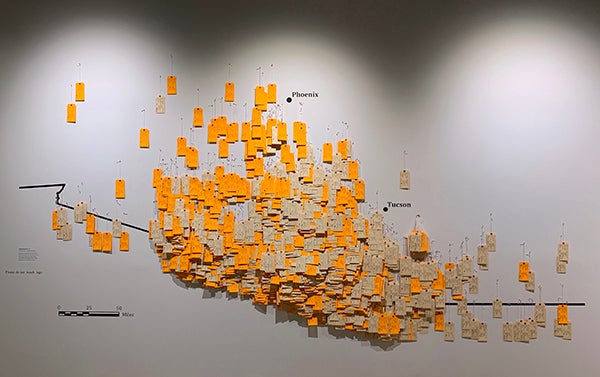ECU hosts Hostile Terrain 94, highlighting humanitarian crisis at U.S.-Mexico border

Toe tags on a map of the Arizona-Mexico border show where migrants died while attempting to cross into the United States. (Photo by the Undocumented Migration Project)
East Carolina University is co-hosting Hostile Terrain 94, a set of global events occurring in more than 150 cities that illuminate the humanitarian crisis occurring at the United States and Mexico border. The events are a participatory art project supported and organized by the Undocumented Migration Project, a nonprofit arts-education-research collective aiming to humanize the migrant experience. ECU events run through Sept. 1 and are co-sponsored by the Thomas Harriot College of Arts and Sciences and the Department of Anthropology, with partial funding by the North Carolina Humanities Council.
The Hostile Terrain 94 website indicates that in 1994, the U.S. Border Patrol launched the immigration enforcement strategy known as prevention through deterrence or PTD.
PTD was designed to deter undocumented migrants from attempting to cross the U.S.-Mexico border near urban points of entry, funneling them toward more remote and depopulated regions. The Border Patrol expected that traveling through the Sonoran Desert, which they called ‘hostile terrain,’ would discourage migrants from attempting the journey.
However, PTD failed to stop border crossers. The Hostile Terrain 94 organizers write that more than 6 million people have tried to travel through the desert since the 90s, and as of 2019, at least 3,200 people died — largely from dehydration, hyperthermia or heat stroke. PTD is still the primary border enforcement strategy being used today.
Dr. Megan Perry, ECU professor of anthropology and Harriot College’s director of international initiatives, is familiar with the Undocumented Migration Project and its director Dr. Jason de León, an anthropologist and MacArthur Fellow. She felt this issue would have particular resonance in eastern North Carolina, the destination for many individuals crossing the border.
“These people are often invisible members of our community,” Perry said. “Understanding the dire risks many took to be here — essentially cheating death — helps us empathize with the decisions they and many others around the globe have made to leave their homes for a better life.”
ECU sponsored events include an installation exhibit along the first-floor hallway of Joyner Library through Sept. 1; the “Art of Migration” exhibit in the library’s Faulkner Gallery, featuring artists Susan Harbage Page and Sally Jacobs, opening March 22; a virtual film screening of “A Stranger’s Table,” with a panel discussion to be scheduled later in March; a virtual lecture by Dr. Gregory Hess, chief medical examiner in Pima County, Arizona, on March 25; a virtual lecture by Juvencio Rocha Peralta, director of AMEXCAN, on April 8; and a virtual film screening of “Border South,” on April 22.
The installation exhibit in Joyner Library, which features 8-feet-high by 16-feet-long maps, is composed of more than 3,200 color-coded, handwritten toe tags that represent migrants who have died trying to cross the Sonoran Desert of Arizona. The tags are geolocated on a wall map of the desert showing the exact locations where remains were found. Manilla tags are used for identified bodies, and approximately 1,000 orange tags represent remains that are unidentified. Each map installation includes an introduction explaining the project as well as an augmented reality experience that may be accessed for free using a cell phone app. Due to COVID restrictions, the art installations currently are only open to the ECU community with a 1Card, but the library is working on providing virtual access to the installations.
For more information and to register for any of ECU’s virtual events, visit the university’s Hostile Terrain 94 website. For questions about the events, contact Perry at perrym@ecu.edu or 252-328-9434.

A border wall extends along the Arizona-Mexico border. (Photo by Michael Wells)